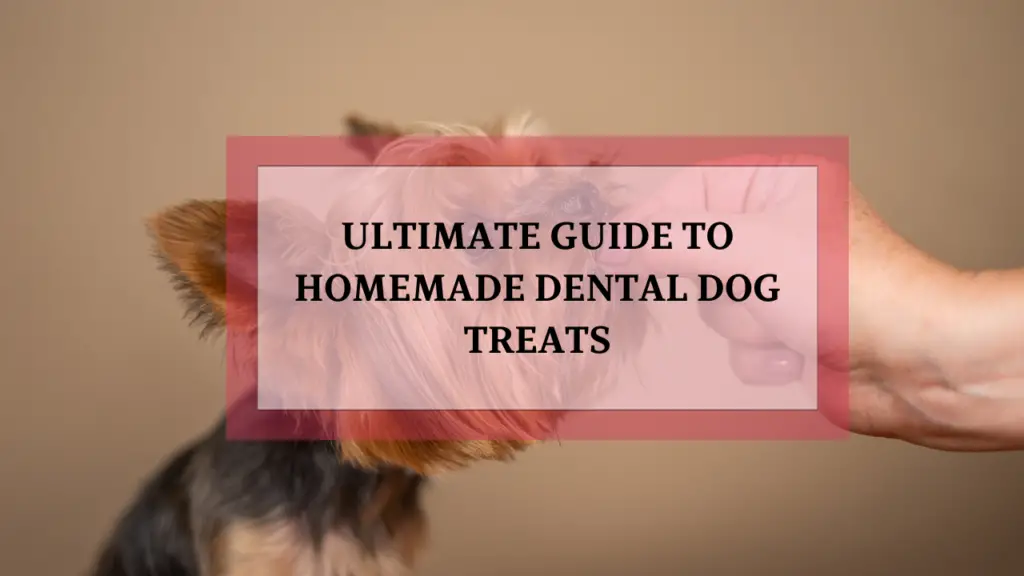Dental health is just as important for dogs as it is for humans, yet it’s often overlooked by pet owners. Just like us, dogs can suffer from a range of oral health issues, from bad breath to severe dental diseases. That’s where homemade dental dog treats come into play! Not only can they help improve your dog’s oral hygiene, but they also give you full control over what goes into the treats.
In this guide, we’ll walk you through everything you need to know about homemade dental dog treats—from the benefits of making your own to simple recipes you can try at home. So let’s dive in!
Why Dental Health Matters for Dogs
Good dental health is a cornerstone of your dog’s overall well-being. Poor oral hygiene can lead to various health problems such as bad breath, gum disease, and tooth decay. These issues not only cause discomfort for your pet but can also lead to more serious conditions, including infections, heart disease, and kidney problems.
Common Dental Problems Dogs Face:
- Bad Breath: The most obvious sign of dental issues. It’s usually a result of plaque buildup.
- Tartar Buildup: When plaque hardens, it turns into tartar, which can cause gum inflammation and tooth loss.
- Gum Disease: Gingivitis, the early stage of gum disease, can progress to periodontitis if untreated.
Providing your dog with regular dental care, like brushing, chew toys, and dental dog treats, is an excellent way to prevent these issues. That’s why homemade dental dog treats can be a vital addition to your pet’s dental routine.
Benefits of Homemade Dental Dog Treats
There’s a growing trend among pet owners to switch from store-bought dental treats to homemade dental dog treats. But why is that?
1. Control Over Ingredients
Homemade treats allow you to choose high-quality, safe ingredients. You can skip the artificial preservatives, colors, and flavors found in some commercial dog treats. Plus, you can customize the texture and flavor to suit your dog’s preferences.
2. Customization for Specific Needs
Every dog is different, and homemade treats give you the flexibility to adjust the recipe for your dog’s dietary restrictions, allergies, or health conditions. For example, you can make grain-free treats for dogs with gluten sensitivities.
3. Cost-Effective
Making your own dental treats can save you money in the long run. Although some high-quality dental treats can be pricey, homemade dental dog treats are budget-friendly, especially when you buy ingredients in bulk.
Key Ingredients for Homemade Dental Dog Treats
Creating your own dental dog treats doesn’t require a bunch of fancy ingredients. In fact, many of the ingredients you need are likely already in your kitchen. Below are some key ingredients that promote healthy teeth and gums in dogs.
Dental-Specific Ingredients:
- Baking Soda: Baking soda helps neutralize odors and can assist in breaking down plaque on teeth.
- Parsley: Known for its ability to freshen breath, parsley is often used in homemade dog treats for dental health.
- Carrots: These crunchy veggies are naturally abrasive, helping to scrape away plaque and tartar.
- Coconut Oil: Aside from its health benefits, coconut oil can help reduce plaque buildup and promote healthy gums.
Basic Ingredients You Need:
- Whole Wheat Flour, Oat Flour, or Rice Flour: These are the primary base for most dog treat recipes. Choose one that fits your dog’s dietary needs.
- Eggs: Eggs are used as a binder in most dog treats and are a great source of protein.
- Broth (Chicken or Beef): Adds flavor and moisture to the dough. Opt for low-sodium broth to keep treats healthy.
- Other Add-ins: Peanut butter, pumpkin, and sweet potatoes are excellent add-ins that make treats both tasty and nutritious.
These ingredients are all packed with vitamins and minerals that contribute to your dog’s overall health while keeping their teeth clean and strong.
How to Make Homemade Dental Dog Treats
Making homemade dental dog treats is easy and can be done in just a few simple steps. Here’s a basic recipe to get you started!
Carrot and Parsley Dental Dog Treats
Ingredients:
- 1 cup whole wheat flour
- 1/2 cup rolled oats
- 1/2 cup carrots, grated
- 2 tbsp fresh parsley, finely chopped
- 1 egg
- 1/4 cup low-sodium chicken broth
- 1 tsp baking soda
Instructions:
- Preheat your oven to 350°F (175°C).
- In a large bowl, mix together the flour, oats, grated carrots, and parsley.
- Add the egg, chicken broth, and baking soda, and mix until a dough forms.
- Roll out the dough to about 1/4 inch thickness and cut it into shapes using cookie cutters.
- Place the cut-out shapes on a baking sheet lined with parchment paper.
- Bake for 15-20 minutes, or until golden brown and crisp.
- Allow treats to cool before serving.
Sweet Potato & Coconut Oil Dental Treats
For a variation, try these delicious sweet potato and coconut oil treats.
Ingredients:
- 1/2 cup mashed sweet potato
- 1/4 cup coconut oil, melted
- 1 cup oat flour
- 1 egg
Instructions:
- Preheat your oven to 350°F (175°C).
- In a bowl, mix the mashed sweet potato, coconut oil, and egg.
- Gradually add oat flour until the dough comes together.
- Roll out the dough and cut into shapes.
- Bake for 15 minutes, or until firm.
Best Practices for Storing Homemade Dental Dog Treats
Once you’ve made your homemade dental dog treats, it’s important to store them properly to ensure they stay fresh and safe for your dog.
Storage Tips:
- Room Temperature: Store treats in an airtight container at room temperature for up to one week.
- Freezing: For longer shelf life, you can freeze the treats in a freezer bag for up to 3 months.
- Refrigeration: If your treats contain perishable ingredients (like chicken broth), store them in the fridge for up to two weeks.
How to Tell if Treats Have Gone Bad:
- If the treats develop a sour smell or mold, discard them immediately.
How Often Should You Give Dental Dog Treats?
You might be wondering how often you should give your dog dental treats. The answer depends on your dog’s size, breed, and dental health.
General Guidelines:
- Small Dogs: 1-2 dental treats per day.
- Medium to Large Dogs: 2-3 treats per day.
- Puppies: Dental treats should be introduced at about 6 months of age, and the frequency should be adjusted based on their size.
Remember, dental treats should complement regular brushing and veterinary checkups—not replace them. They’re a part of a comprehensive oral care routine.
Can Homemade Dental Treats Replace Brushing?
While homemade dental dog treats can significantly improve your dog’s oral health, they should not completely replace regular tooth brushing. Brushing your dog’s teeth at least 2-3 times per week is still necessary to prevent plaque buildup, especially in areas your dog can’t reach on their own.
Dental treats are great for supplementing your dog’s oral hygiene, but they can’t do the job of a toothbrush. It’s best to combine both methods for optimal results.
Potential Risks of Homemade Dental Dog Treats
Though homemade treats are generally safe, there are a few potential risks you should be aware of:
- Overfeeding: Like all treats, dental dog treats should be given in moderation. Too many treats can lead to weight gain.
- Allergies: Always check the ingredients before making treats to ensure your dog isn’t allergic to any of them.
- Hardness: Some treats might be too hard for older dogs or dogs with sensitive teeth. Always monitor your dog while they’re enjoying their treats.
How to Make Homemade Dental Dog Treats Fun for Your Pup
Introducing new treats into your dog’s routine can be exciting for both of you! Here are a few tips to keep it fun:
- Use dental treats as part of a positive reinforcement training session.
- Vary the flavors and textures to keep your dog interested.
- Try interactive treat puzzles: Hide homemade treats in puzzle toys to make dental care fun and stimulating.
Homemade vs. Store-Bought Dental Dog Treats: Which is Better?
When it comes to choosing between homemade and store-bought dental dog treats, there are pros and cons to both.
Homemade Dental Dog Treats:
- Pros: Full control over ingredients, customizable for your dog’s needs, budget-friendly.
- Cons: Requires time to prepare and bake.
Store-Bought Dental Dog Treats:
- Pros: Convenient, often formulated with specialized ingredients for dental care.
- Cons: Can be more expensive, may contain artificial additives.
Ultimately, homemade treats are a fantastic choice if you have the time and want to ensure your dog’s treats are natural and free from harmful chemicals.
Frequently Asked Questions About Homemade Dental Dog Treats
Can I use regular dog treats for dental health?
While some regular dog treats may help with oral health, they are usually not as effective as dental-specific treats that are designed to reduce plaque and tartar buildup.
Are dental treats safe for puppies?
Yes! Dental treats can be given to puppies once they have all their adult teeth, typically around 6 months of age. Always check for age-appropriate treats.
How long does it take to see results from dental treats?
You may start seeing an improvement in your dog’s breath and overall dental health within 2-3 weeks, but long-term benefits require consistent use.
What if my dog doesn’t like the taste of dental treats?
If your dog doesn’t enjoy dental treats, try experimenting with different flavors, like peanut butter or chicken broth, to find one they love.
Conclusion
Homemade dental dog treats are an excellent way to improve your dog’s oral health while providing a natural, safe alternative to commercial products. With simple ingredients, customizable recipes, and the ability to store them for future use, these treats offer a great way to keep your dog’s teeth clean and healthy.
If you’ve never tried making dental treats before, we encourage you to give it a go. Your dog will thank you with a wagging tail and a healthier smile!



